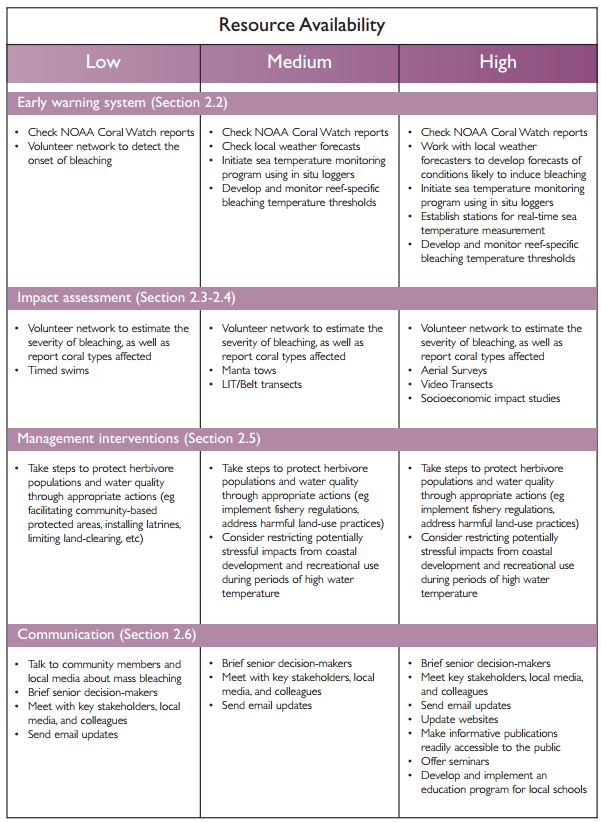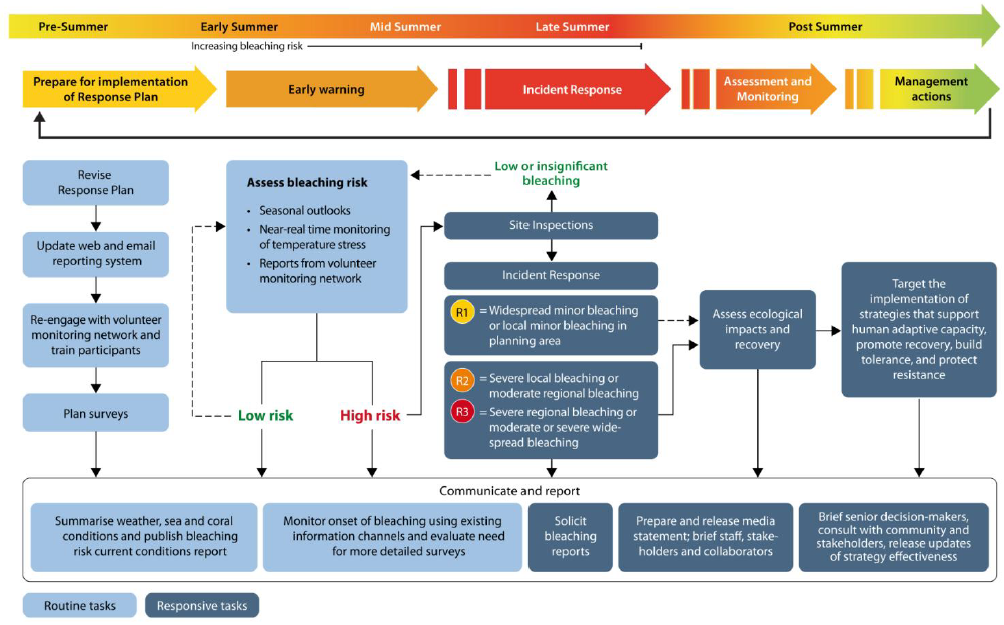Coral Bleaching
While the causes of coral bleaching are beyond the direct influence of local management, reef managers have important roles to play before, during, and after bleaching events.
Managers are likely to have a range of responsibilities associated with bleaching events including: predicting and communicating risks, measuring impacts, understanding the implications for reef resilience, and implementing management responses to minimize the severity of damage and/or assist with reef recovery.
Bleaching events can develop suddenly, with little time for preparation and mounting a response. Bleaching response plans are an important tool for ensuring reef managers are ready and able to respond appropriately to coral bleaching events. A bleaching response plan describes the steps for detecting, assessing, and responding to bleaching events. It enables managers to be ready should a bleaching event occur. This can be important for the way the incident is portrayed in the media, for ensuring credibility with stakeholders, and to prepare for appropriate management actions. Bleaching response plans commonly have a combination of routine and responsive tasks; responsive tasks are implemented when certain thresholds or triggers are reached.
This table provides examples of the types of activities that could be implemented under each element for three different resource/capacity scenarios (low, medium, and high resource availability).

Table 2.1 Examples of tasks from four categories of bleaching response actions under three different resource scenarios from A Reef Manager's Guide to Coral Bleaching (2006)
Bleaching response plans can take many forms, from a complete management response framework (e.g., Great Barrier Reef Marine Park Authority’s Incidence Response System) including an incident control system and field procedures to a simple one-page description of key steps and triggers. The four main elements of a bleaching response plan are: 1) an early warning system; 2) impact assessment; 3) management interventions; and 4) communications.

Coral bleaching response plan developed by the Great Barrier Reef Marine Park Authority (GBMPA) in Australia. Source: GBRMPA 2011
Developing a Bleaching Response Plan
Pre-planning before a bleaching event allows managers to quickly respond when bleaching happens. It is critical to plan ahead for staffing, funding, communications, and monitoring. Having a plan in place will also help managers to gain credibility and political support with reef users and decision-makers. When developing bleaching response plans, it is important to include relevant stakeholders and partners, as well as senior officers from within the management organization. Clearly defining the roles and responsibilities of all organizations and individuals involved in a response is also crucial to the effectiveness of a plan.
Once a reef has been affected by a coral bleaching event, managers might wish to consider local management interventions or restoration strategies to support recovery processes. However, coral bleaching events often occur at spatial scales of tens to hundreds of kilometers, making restoration an expensive and difficult – if not impossible – prospect.
The Reef Resilience Network developed a worksheet to guide managers through developing a bleaching response plan. This tool can help managers consider a range of issues that support a response, including:
- Predicting mass bleaching events
- Setting thresholds for response actions
- Assessing the ecological and socio-economic impacts of mass bleaching
- Monitoring pre- and post-bleaching to identify resilient reef areas
- Communicating about mass bleaching before, during, and after the event
- Implementing management interventions that may increase coral survival during events
- Securing funding for a response
- Identifying and strengthening capacities required for a response
Monitoring and Predicting Coral Bleaching
Predicting mass coral bleaching events is a key step to any coral bleaching response plan. Different coral bleaching prediction and monitoring tools are now available to managers including:
For more information on these tools, refer to the page on mass bleaching events.
Resources
Coral Bleaching: Toolkit & Comprehensive Guide from the Coral Reef Alliance
A Reef Manager’s Guide to Coral Bleaching
Great Barrier Reef Marine Park Authority Coral Bleaching Response Plan
Florida Reef Tract Coral Bleaching Response Plan
Florida Coral Reef Resilience Program - Lessons Learned from the 2023 Bleaching Event
Webinar Recording - Lessons Learned from the 2023 Caribbean Bleaching Event and Preparing for 2024
TNC Bleaching Response Plan Worksheet
Coral Reef Resilience Online Course, Lesson 6: Management Strategies for Resilience
